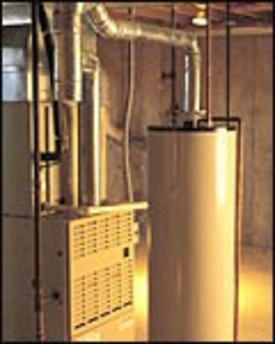Boilers, burners, pipes, pumps, fans, circulators, zones, and thermostats are all parts in the kit that makes up most heating systems. Each piece has its role to play in making heat, distributing it, venting it or controlling it. Understanding how they all work together will help you plan for maximum comfort and safety, while keeping a watchful eye for conditions that might require immediate action.
Making Heat
With any system, the primary component for heat production is the furnace or burner. Here the process of combustion, or the breaking open of the energy bundles stored in fuel, takes place. The heat that is produced is measured in Btu, British thermal units, which describe heat production by the hour. Fuels are also assigned heat values with a Btu rating per gallon or per cubic foot. A furnace can be sealed combustion or non-sealed combustion. This describes how the unit receives the air it needs to function and burn the fuel. A sealed combustion furnace will draw air directly through a duct that leads from the furnace to the outside. A non-sealed combustion unit draws air from the space around it, the house itself.
Keeping It Moving
 |
||||
|
||||
To get heat from the burner to the house, every system has a distribution pathway. For forced hot-air heat, metal ducts are used to carry the air to in-room registers. A blower or fan is used to push the air through the ducts to its destination. This fan cycles on and off with the furnace and is responsible for keeping the hot air from backing up into the system. Timed to cycle off shortly after the burner shuts down, the timing of the fan is what keeps cold air from being pushed through the system, as well. Equally important to the production of hot air heat is the return air supply that is used to fuel the system. It is essential that the amount of air space dedicated to the supply (hot) and return (cold) air be the same in a forced air system.
With domestic hot-water or hydronic heat, supply and return issues center on water and the pipes that carry it. With hydronic heat, the boiler fires and heats the water to an average temperature of 180°F to 200°F for baseboard heat and 80°F to 85°F for radiant floors. This hot water is pushed through copper or PEX tubing via a circulator or pump. As it travels through the house, heat is either transferred to slats or "fins" located along the pipes in baseboard registers or transferred directly to a wall panel, the floor or ceiling. Return water re-enters the boiler at a temperature of 110°F and is carried either through its own return pipe or through a series of registers culminating at the boiler.
Controlling the Output
In a hydronic system, heating by room is controlled via thermostats and zone valves installed on the supply pipe to encourage or prevent hot water from entering a given loop. Some systems have individual circulators for each zone, sending hot water to that baseboard or heating zone only when called for by the thermostat. Another option is the thermostatic radiator valve which opens to allow hot water into the baseboard and closes when the area reaches the design temperature. Options will vary depending on the area to be heated, how frequently it is in use, and whether immediate heat is required, as with bathrooms.
Forced air heat is always immediate, arriving with a burst to heat the air in the room that calls for it. Forced hot air travels along trunks and branches to reach its destination. When the burner fires, the fan distributes the hot air to open pathways and registers. Dampers placed along the trunk at branch locations prevent the hot air from entering certain zones when they are closed.
Credit: Renovate Your World




























